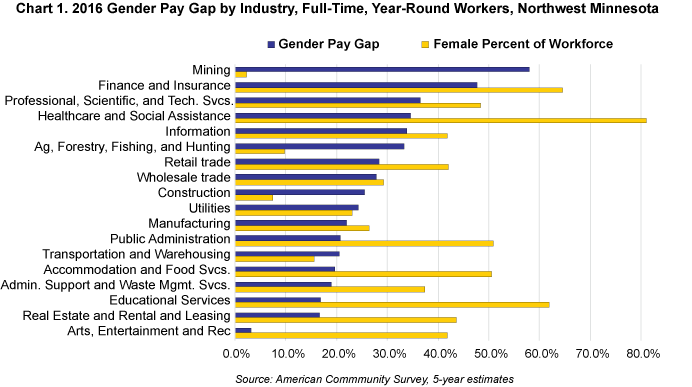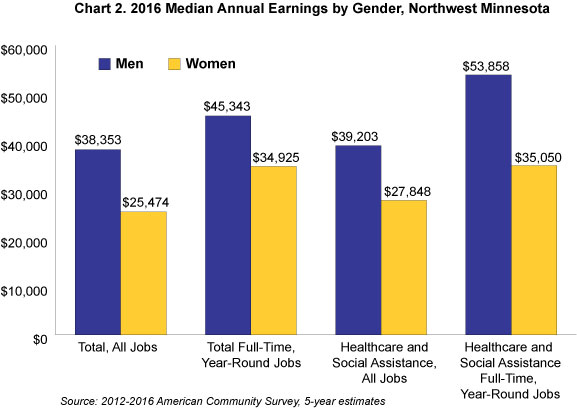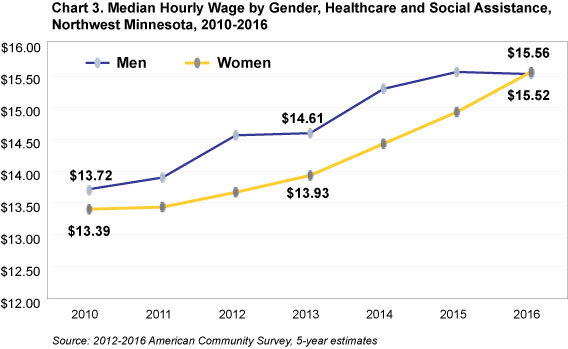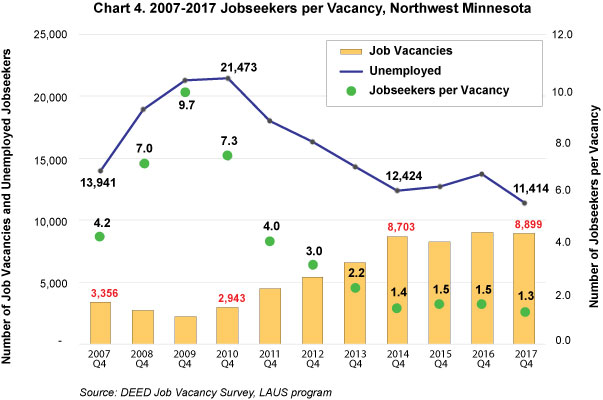by Chet Bodin
April 2018
In 2018 the online financial advisor WalletHub concluded that Minnesota is the best state for women to live and work in, citing factors such as educational attainment, business ownership, and rate of poverty in making the distinction. But despite the welcome accolades, an obstinate gender pay gap exists across the state.
According to the Census Bureau’s American Community Survey (ACS), the unadjusted earnings ratio in Minnesota, or women’s earnings as a percent of men’s, was approximately 71.3 percent in 2016. By industry, the earnings ratio ranges from 51 percent in the Agriculture, Forestry, Fishing, and Hunting sector to 89 percent in Real Estate and Rental and Leasing. Overall, the gender pay gap is even larger in Northwest Minnesota, where the earnings ratio was approximately 66.4 percent in 2016. There are many ways to examine the gender pay gap, however. Industry sector, hours worked, level of education, and occupation can each contribute to the gender pay gap, positively or negatively.
One of the most glaring factors associated with gender pay gaps is the number of hours worked. Even if the pay is the same, one gender will earn more over the course of a pay period or on an annual basis if the gender works more hours. It should be noted, however, that the average number of hours worked can vary even among full-time employees. So while comparing the earnings of full-time, year-round workers provides a more accurate assessment of the gender pay gap than comparing overall earnings, it does not completely control for the number of hours worked.
Among full-time, year-round workers in Northwest Minnesota, a gender pay gap exists in every regional industry, although it varies from sector to sector. The Arts, Entertainment, and Recreation industry had the smallest pay gap, where women earn approximately 97 percent of what men earn. On the other end of the spectrum, women earn only 42 percent of what men earn in Mining, where the pay gap is over 10 percent larger than in any other industry. The top three industries in terms of employment – Health Care and Social Assistance, Manufacturing, and Retail Trade – had the 4th, 11th, and 7th largest gender pay gaps, respectively (see Chart 1).

Perhaps unsurprisingly, the sector with the largest gender pay gap, Mining, also had the smallest representation of women in the workforce. However, in other industries the relationship between workforce representation and the size of the gender pay gap is much less consistent. For example, less than 10 percent of workers in Construction are women, but the industry’s gender pay gap is less than half the size of that in Mining. On the other hand, despite having a workforce that is nearly 65 percent female, Finance and Insurance has the second largest gender pay gap, as the median earnings of women in the industry are 48 percent lower than those of men in Northwest Minnesota.
Educational attainment also affects wages, and adds more context to the gender pay gap conversation. If men have higher average educational attainment, it would follow that they would also have higher wages, which would in part explain the pay gap. As it turns out, however, a higher percentage of women aged 25 years and older have bachelor’s degrees in Northwest Minnesota, and roughly the same percentage of each gender has graduate or professional degrees (see Table 1).
| Table 1. Educational Attainment by Sex for the Population 25 Years and Older | |||
|---|---|---|---|
| Gender/Degrees | Number | Percent | *Median Annual Earnings |
| Men, 25 years and older | 188,240 | 100.0% | $40,449 |
| Bachelor's Degree | 28,393 | 15.1% | $52,165 |
| Graduate or Professional Degree | 13,025 | 6.9% | $62,426 |
| Women, 25 years and older | 191,071 | 100.0% | $27,240 |
| Bachelor's Degree | 33,029 | 17.3% | $37,010 |
| Graduate or Professional Degree | 12,482 | 6.5% | $53,450 |
|
*Among working residents Source: 2012-2016 American Community Survey, 5-year estimates |
|||
Interestingly, the wage gap shrinks at each level of education, signaling that women with bachelor's degrees or higher are able to earn closer to what men earn in Northwest Minnesota. Still, the regional pay gap is approximately 29 percent for women with bachelor's degrees, and 14 percent for those with graduate or professional degrees.
There are several possible reasons for this. As noted previously, the number of hours worked is likely to factor in heavily. But the industries that women choose to work in and the wage levels associated with those industries is also a factor. In Northwest Minnesota women with bachelor's degrees are more likely to work in industries that pay lower wages, while men are more likely to work in higher-paying sectors. For example, in 2016 more than 50 percent of women over 25 years of age who had bachelor's degrees or higher worked in Education and Health Services, where the average annual wage for bachelor's degree holders in the region was $60,669. Compared to their female counterparts, men of similar age and educational attainment worked more often in industries such as Wholesale Trade, Manufacturing, and Professional, Scientific, and Technical Services, each of which paid more on average for those with bachelor's degrees or higher. In total, 18.2 percent of men with bachelor's degrees or higher worked in the top five paying industries, compared to 11.4 percent of women.
Perhaps more than any other industry, Healthcare and Social Assistance would benefit by addressing the gender pay gap. Regionally, the industry employs the most workers in Northwest Minnesota, and relies heavily on a female workforce. Over 80 percent of regional Healthcare and Social Assistance workers are women, and the healthcare industry is projected to grow by 16.5 percent from 2014 to 2024, adding another 5,369 regional jobs. This represents more than half of the total job growth projected in Northwest Minnesota over the 10 year period.
DEED recently published a statewide study of the gender pay gap in Healthcare and Social Assistance, which showed that the gender pay gap decreased when hours worked was taken into account. In Northwest Minnesota, data from the American Community Survey (ACS) show that in 2016 women's median annual earnings in Healthcare and Social Assistance were 71 percent of those for men (see Chart 2). Like the statewide study, it would be reasonable to expect the pay gap to decrease when accounting for hours worked. If men worked full-time more often, it follows they would earn more on average than women over time, all else being equal. However, when comparing those who work full-time, the wage gap increased, with women earning 65 percent of men annually.

Some of this can be explained by the difference in the type of healthcare occupations held by men and women. The ACS shows that over 63 percent of men in Northwest Minnesota employed in healthcare occupations work in the highest-earning health diagnosing and treating practitioners category, compared to 42 percent of females (see Table 2). Furthermore, females account for 92 percent of the 3,756 people employed in full-time, year-round healthcare support occupations, which offer much lower wages.
-| Table 2. 2016 Full-Time, Year-Round Healthcare Occupations by Gender, Northwest Minnesota | ||||
|---|---|---|---|---|
| Healthcare Occupations | Male Employment | Percent of Male Employment | Female Employment | Percent of Female Employment |
| Total, Healthcare Occupations | 2,542 | 100.0% | 11,168 | 100.0% |
| Health diagnosing and treating practitioners | 1,612 | 63.4% | 4,690 | 42.0% |
| Health technologists and technicians | 615 | 24.2% | 3,037 | 27.2% |
| Healthcare support occupations | 315 | 12.4% | 3,441 | 30.8% |
| Source: 2012-2016 American Community Survey 5-Year Estimates | ||||
Whether the difference in healthcare jobs is enough to explain fully the gender wage gap in health care is difficult to tell. After all, this industry has other occupations besides those which are specifically healthcare-oriented, such as administrators, maintenance workers, and even accountants. But it may be that the persistence of traditional occupational roles in our culture and institutions foster the industry's pay gap more than any other factor.
In an encouraging trend DEED's Quarterly Employment Demographics (QED) show that median hourly wages in Healthcare and Social Assistance increased faster for women than for men since the end of the recession. By 2016 median hourly wage rates in the industry were essentially even. So while men might have more high-earning outliers, in both genders 50 percent of workers were making less than approximately $15.50 per hour, and 50 percent of workers were making more (see Chart 3).

Still, both ACS and QED show an overall gender pay gap in Northwest Minnesota and statewide. Further progress toward closing the gender pay gap could affect change at multiple economic levels. For employers who are competing in a tight labor market, taking steps toward equal pay may provide the edge needed to fill vacancies now and in the future. As recently as the fourth quarter of 2017, there were an estimated 8,899 job vacancies and 11,414 unemployed workers in Northwest Minnesota or only 1.3 jobseekers per vacancy (see Chart 4).

In the constraints of a tight labor market, employers in industries throughout Northwest Minnesota will have to tap several sources to fill their employment needs. Although women already fill just over half of the jobs in the region, data show that a gender pay gap exists, which could be addressed to attract workers inside and outside the region. In some cases this may be a reflection of specific wage disparities. However, there is also an opportunity for employers to promote equal pay - and potentially find favor- by encouraging more women to fill leadership roles and high-paying occupations in general.